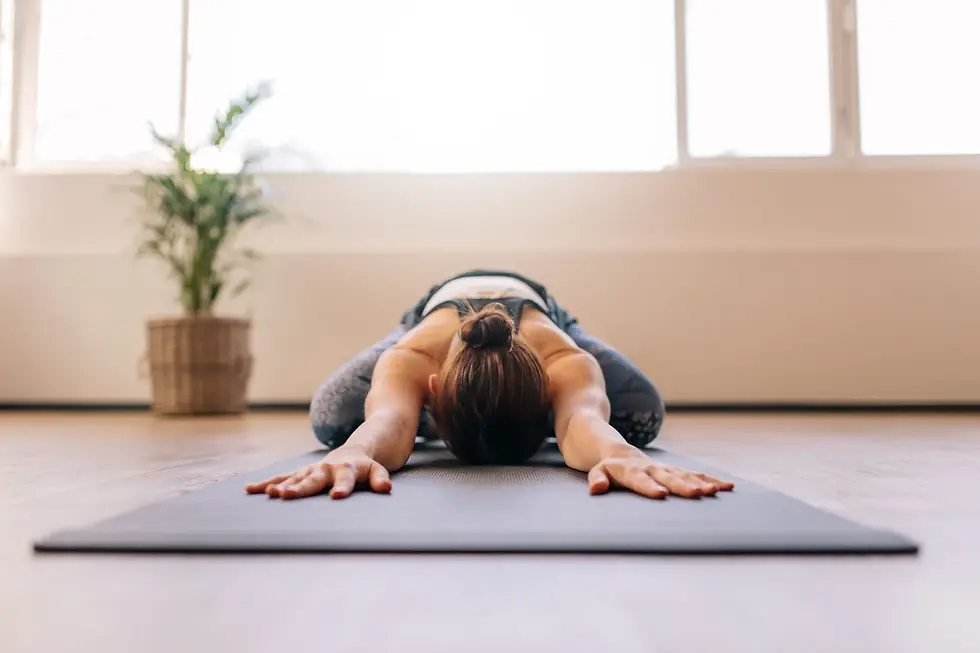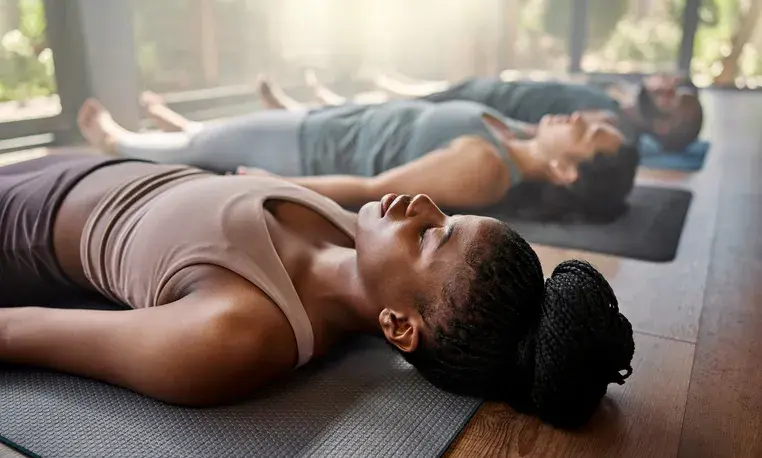8 Powerful Yoga Styles That Actually Work for Anxiety
- YogicEscape Berlin
- Jul 18
- 5 min read
As the modern world accelerates, yoga continues to evolve, fusing timeless philosophy with cutting-edge insights from psychology and neuroscience. With anxiety disorders reaching global highs, emerging yoga styles now offer not just relief but real healing. These eight therapeutic trends combine calming yoga practices and mind-body yoga techniques, forming a deeply effective, evidence-backed approach to easing anxiety.
Rooted in traditional principles but adapted to modern mental health needs, these styles regulate the nervous system, lower cortisol levels, and build long-term emotional resilience. Whether you seek gentle yoga for anxiety, structured breathwork, or mindful movement, these practices are shaping the future of wellness.
1. Trauma-Informed Yoga: Creating a Safe Space for Healing

Trauma-informed yoga focuses on emotional safety and body awareness, essential for those with a history of anxiety or trauma. Rather than imposing poses, this style empowers practitioners to make choices, cultivating autonomy and inner safety.
Instructors use inclusive language and provide alternatives to reduce stress triggers. For example, keeping eyes open during meditation or skipping backbends minimizes exposure and fosters psychological safety. This approach not only lowers anxiety but promotes reconnection with the body.
Trauma-informed classes also build community, vital for individuals facing isolation due to anxiety. The shared experience of healing fosters belonging, making yoga for anxiety a more accessible and compassionate journey.
2. Breathwork Yoga: Harnessing Pranayama for Mental Clarity

Breathwork-focused yoga brings pranayama teacher training in Berlin into daily practice. These sessions explore techniques like alternate nostril breathing and box breathing, offering breathing exercises for anxiety that immediately affect brain and body chemistry.
Practitioners experience quick shifts: decreased heart rate, improved heart rate variability, and a calmer mental state. Integrating breath with slow movement deepens the effect, transforming basic yoga poses for stress and anxiety into mindful therapy.
Even advanced breath retention practices become a form of exposure therapy, teaching students to stay present and calm amid internal stress, a key skill for anxiety management.
3. Sound Healing Yoga: Therapeutic Vibration for Deep Calm

Sound healing yoga combines yoga poses with vibrational frequencies through instruments like singing bowls and tuning forks. These frequencies induce brainwave entrainment, guiding the nervous system into states of deep relaxation and present-moment awareness.
The result? Enhanced emotional healing and a soothing somatic experience. Practitioners feel vibrations move through the body, helping release stored tension and trauma. Sound healing classes in Berlin now often include gentle sequences paired with sound, creating a full-spectrum approach to calming the mind.
Practicing in groups intensifies the effect, using shared resonance to create collective healing, an ideal addition to your routine if you're exploring yoga therapy for anxiety.
4. Micro-Yoga Breaks: Anxiety Relief in Minutes

Short on time? Micro-yoga is the answer. These 5–15-minute sequences deliver targeted relief by addressing real-life stress points. Ideal for home or office use, these practices focus on posture correction, breath awareness, and quick tension release.
Best of all, they're consistent. You don’t need to change clothes or roll out a mat. Whether it’s a calming desk sequence or a grounding pose between meetings, these short breaks activate the parasympathetic nervous system, offering sustainable relief throughout the day.
Many Yogicescape classes now incorporate micro-sessions via mobile reminders or wearable integrations, making calming yoga practices available anywhere, anytime.
5. Yin Yoga: Passive Stillness for Deep Release

Yin yoga for emotional healing targets the fascia, the connective tissue, where much of our tension and trauma are stored. By holding passive poses for several minutes, the nervous system slowly downshifts, encouraging long-term anxiety relief.
This deeply meditative practice encourages surrender and internal focus. Supported by props like bolsters or blankets, students can safely soften into stillness. The release is often both physical and emotional.
For those seeking gentle yoga for anxiety, yin yoga offers an accessible way to cultivate presence, patience, and self-compassion, all critical for reducing chronic stress patterns.
6. Nature-Based Yoga: Reconnecting with Earth Energy

Practicing yoga outdoors, whether in city parks or forested retreats, intensifies the therapeutic effects. Natural settings reduce cortisol, while outdoor movement aligns the body’s rhythms with nature.
Seasonal variations in outdoor practice also help regulate internal balance. In spring or summer, flow-based sequences energize the system; in colder seasons, grounding poses offer warmth and inner focus. Practicing with the elements creates adaptability, fostering resilience that counteracts anxiety triggers.
Yogicescape frequently hosts retreats and yoga classes in Prenzlauer Berg that integrate nature-based elements for emotional healing and restoration.
7. Yoga Nidra: Yogic Sleep for Deep Nervous System Repair

Yoga Nidra, or “yogic sleep,” offers a unique way to relax deeply without movement. Practitioners lie down and follow guided relaxation through breath, body scans, and visualization. This conscious sleep state fosters brainwave activity linked with restoration.
Yoga Nidra helps rewire the brain’s anxious tendencies and has been shown to improve sleep, mood, and focus. It’s also highly inclusive; no prior yoga experience or physical mobility is needed.
Use it before bed or during the day to reset the nervous system. For those battling chronic anxiety, this form of daily yoga for stress relief can be life-changing.
8. Mindful Flow: Movement as Meditation

Mindful Flow combines vinyasa yoga for anxiety reduction with present-moment awareness. Each breath becomes a bridge to mindfulness. Practitioners move slowly and intentionally, heightening interoception, the awareness of internal bodily sensations.
By tuning into these micro-movements, you develop emotional regulation and learn how yoga helps with anxiety by building tolerance for discomfort and change. This style not only soothes the mind but also teaches valuable life skills for managing transitions and emotional waves.
Mindful flow is taught in many Yoga Studio in Friedrichshain locations, blending modern somatic psychology with traditional movement for powerful, grounded healing.
Yogicescape offers yoga classes in Prenzlauer Berg and Yoga Studio in Friedrichshain, including sound healing classes, breathwork training, and trauma-informed sessions.
FAQs
1. What is the best type of yoga for anxiety?
Trauma-informed yoga, yin yoga, and mindful flow are among the best yoga styles for anxiety due to their focus on emotional safety, deep relaxation, and present-moment awareness.
2. Can breathwork really reduce anxiety?
Yes. Breathwork-focused yoga and pranayama techniques activate the parasympathetic nervous system, lower cortisol, and help manage acute stress in real-time.
3. How often should I practice yoga for anxiety relief?
Daily practice, even for just 10–15 minutes, can significantly reduce anxiety symptoms. Consistency is more important than duration.
4. Are sound healing yoga classes effective for mental health?
Absolutely. Sound healing creates vibrational frequencies that help the brain enter calm, healing states, especially when combined with gentle movement and meditation.
5. Where can I find anxiety relief yoga classes in Berlin?
Yogicescape offers yoga classes in Prenzlauer Berg and Yoga Studio in Friedrichshain, including sound healing classes, breathwork training, and trauma-informed sessions.




Was für ein aufschlussreicher Artikel! Er erklärt die Kriterien für eine PTBS-Diagnose auf eine sehr verständliche Weise. Für Betroffene ist es oft schwer, das eigene Erleben in Worte zu fassen. Ein strukturierter Fragebogen kann hier eine große Hilfe sein. Eine Webseite, die den PCL-5 Fragebogen online anbietet, gibt Betroffenen die Möglichkeit, ihre Symptome systematisch zu erfassen, was auch für ein späteres Gespräch mit einem Therapeuten sehr wertvoll sein kann.
Es ist faszinierend, wie Sie den subtilen Unterschied in der Zeitwahrnehmung zwischen digitalen und analogen Anzeigen hervorheben. Ich stimme vollkommen zu, dass das physische Fortschreiten der Zeiger ein intuitiveres Verständnis für den Verlauf des Tages vermittelt, etwas, das bei einer reinen Ziffernanzeige oft verloren geht. Angesichts der zunehmenden Digitalisierung unseres Alltags stellt sich jedoch die Frage, wie man die Ästhetik und Funktionalität klassischer Zeitmesser am besten in moderne Umgebungen integrieren kann, ohne auf deren zeitlose Vorteile zu verzichten. Wer sich tiefer mit die Welt der analogen Uhren beschäftigen möchte, findet dort eine hervorragende Ressource.